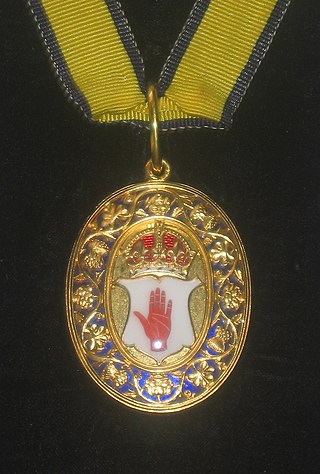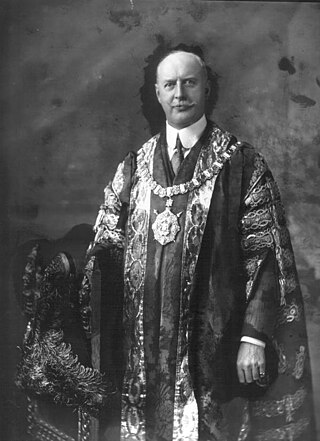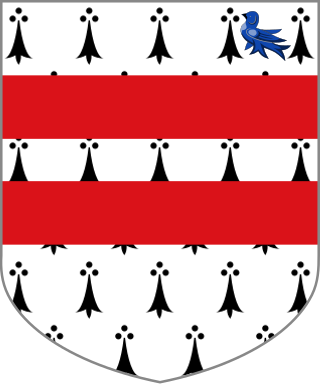
A baronet or the female equivalent, a baronetess, is the holder of a baronetcy, a hereditary title awarded by the British Crown. The title of baronet is mentioned as early as the 14th century; however, in its current usage it was created by James I of England in 1611 as a means of raising funds for the crown.

Viscount Cobham is a title in the Peerage of Great Britain that was created in 1718. Owing to its special remainder, the title has passed through several families. Since 1889, it has been held by members of the Lyttelton family.

Baron Avebury, of Avebury in the County of Wiltshire, is a title in the Peerage of the United Kingdom. It was created 22 January 1900 for the banker, politician and archaeologist Sir John Lubbock, 4th Baronet. He was succeeded by his eldest son, the second Baron. On his death the titles passed to his nephew, the third Baron. He was the son of Harold Fox Pitt Lubbock, fourth son of the first Baron, who died in 1971. The title then passed to the third Baron's first cousin, the fourth Baron, the son of Maurice Fox Pitt Lubbock, sixth son of the first Baron. The fourth baron was a Liberal Democrat politician and one of the ninety excepted hereditary peers who remained in the House of Lords after the passing of the House of Lords Act 1999. He was succeeded by his son, the fifth Baron, in 2016.
The Baronetcy of Temple, of Stowe, in the Baronetage of England, was created on the 24th of September 1611 for Thomas Temple, eldest son of John Temple of Stowe, Buckinghamshire. His great-grandson Sir Richard, 4th Baronet, was created Baron Cobham on 19 October 1714, and Viscount Cobham and Baron Cobham on 23 May 1718, the latter with a special remainder, failing his male issue to his sisters and their heirs male. Upon his death on the 13th September 1749, the barony of 1714 became extinct. Both the viscountcy and barony of 1718 passed to his elder sister, and the baronetcy passed to his second cousin once removed William Temple, of Nash House, who became 5th Baronet. On the death of Sir William's nephew Sir Richard Temple, 7th Baronet, on 15 November 1786, the baronetcy became dormant.
There have been three baronetcies created for members of the Anstruther family, two in the Baronetage of Nova Scotia and one in the Baronetage of Great Britain. Two of the creations are extant while one is extinct.

There have been nine baronetcies held by people with the surname Nugent, four in the Baronetage of Ireland and five in the Baronetage of the United Kingdom. Six of the creations are extinct, while three are extant.

There have been twenty one baronetcies created for persons with the surname Williams, eight in the Baronetage of England, three in the Baronetage of Great Britain and ten in the Baronetage of the United Kingdom. Only six of the creations are extant as of 2017.
There have been four baronetcies created for persons with the surname Child, two in the Baronetage of England and two in the Baronetage of the United Kingdom.
There have been three baronetcies created for persons with the surname Everard, one in the Baronetage of Ireland, one in the Baronetage of England and one in the Baronetage of the United Kingdom. Only one creation is extant as of 2010.

Sir Nugent Talbot Everard, 1st Baronet was an Irish senator nominated to the 1922 Seanad Éireann.

Sir William Frederick Coates, 1st Baronet, was an Irish stockbroker and politician in Belfast.

Sir Walter Richard Nugent, 4th Baronet was an Irish baronet, politician and member of parliament (MP) in the House of Commons from 1907 to 1918.
The High Sheriff of County Waterford was the Sovereign's judicial representative in County Waterford. Initially, an office for a lifetime, assigned by the Sovereign, the High Sheriff became an annual appointment following the Provisions of Oxford in 1258. Besides his judicial importance, the sheriff had ceremonial and administrative functions and executed High Court Writs.
There have been three baronetcies created for persons with the surname Humble, two in the Baronetage of England and one in the Baronetage of the United Kingdom. All are extinct.
John Humble may refer to:
Sir John Dongan, 2nd Baronet (1603–1650) was a member of the Irish Parliament.

The Nugent Baronetcy, of Moyrath in the County of Westmeath, was created in the Baronetage of Ireland on 14 January 1622 for Thomas Nugent. The title became extinct by forfeit after the death of the third Baronet in 1710.

The O'Reilly, later Nugent baronetcy, of Ballinlough in the County of Westmeath, was created in the Baronetage of Ireland on 23 July 1795 for Hugh O'Reilly. In 1812, on the death of his maternal uncle John Nugent, he assumed by Royal licence the surname of Nugent. The third Baronet was Chamberlain to the Emperor of Austria and was also created a Count of the Austrian Empire. The family seat is Ballinlough Castle, Clonmellon, County Westmeath.

The Nugent baronetcy, of Waddesdon in the County of Berks, was created in the Baronetage of the United Kingdom on 28 November 1806 for Field Marshal Sir George Nugent. He was the illegitimate son of the Honourable Edmund Nugent, only son of The 1st Earl Nugent. The 1st Baron Nugent was the younger brother of the fourth Baronet.

The Nugent baronetcy, of Donore in the County of Westmeath, was created in the Baronetage of the United Kingdom on 30 September 1831 for Percy Nugent, a collateral descendant of the holders of the first creation in 1768.











